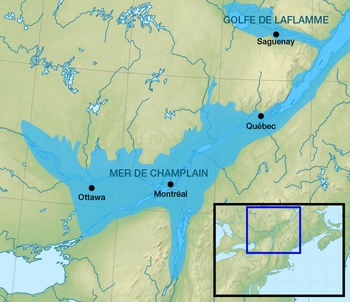Champlain Sea

The Champlain Sea (
Origins
The mass of ice from the continental ice sheets had depressed the rock beneath it over millennia. At the end of the last glacial period, while the rock was still depressed, the
The sea lasted from about 13,000 years ago to about 10,000 years ago and was continuously shrinking during that time, since the rebounding continent was slowly rising above sea level. At its peak, the sea extended inland as far south as
Geological evidence
The best evidence of this former sea is the vast clay plain deposited along the Ottawa and St. Lawrence Rivers.
The northern shore of the lake was in southern Quebec where outcrops of the Canadian Shield form Eardley Escarpment. This escarpment still has distinctive plants that may date back to the era when the sea existed.[16] The Eardley Escarpment is known locally as the Gatineau Hills. It is part of the Mattawa fault at the southeastern edge of the Ottawa-Bonnechere Graben, in Eastern Ontario and the Outaouais region of Quebec, more commonly known as the Ottawa Valley.
See also
- Lake Hitchcock
- Lake Albany
- Wisconsin glaciation
- Saint Lawrence Rift System
References
- ^ L.J. Chapman and D.F. Putnam. 1951. The Physiography of Southern Ontario. University of Toronto Press, Toronto. 284 p. plus map in four sections.
- ^ Anderson, T.W. 1989. Vegetation changes over 12,000 years. Geos 18:39–47.
- ^ "Lake Champlain Basin Atlas: Geology Page". Archived from the original on July 20, 2008.
- ^ "Champlain Sea". 10 April 2022.
- ^ "Paleoceanography of the Champlain Sea, Hanover Park, Canada". Archived from the original on 2004-12-21. Retrieved 2005-02-04.
- ^ a b Barnett, P. J. 1988. "History of the northwestern arm of the Champlain Sea". pp. 25–36 in Gadd, N.R. (ed.) The Late Quaternary Development of the Champlain Sea Basin. Geological Association of Canada, Special Paper 36. Map 5.
- ^ "The Rochester Canyon - The Genesee River Base Levels" (PDF). Retrieved 2023-08-20.
- ^ Chapman, L.J. and D.F. Putnam. 1984. The Physiography of Southern Ontario. Third edition. Ontario Geological Survey, Special Volume No.2. Government of Ontario, Toronto.
- ^ Keddy, C.J. 1993. Forest History of Eastern Ontario. A report prepared for the Eastern Ontario Forest Group.
- ^ "Fossilworks: Gateway to the Paleobiology Database". paleodb.org.
- doi:10.1139/e93-150.
- S2CID 83704610.
- ^ University of Calgary: Champlain Sea fossils Archived February 13, 2005, at the Wayback Machine
- ^ McAllister, D.E., C.R. Harrington, S.L. Cumbaa, and C.B. Renaud. 1988. "Paleoenvironmental and biogeographic analyses of fossil fishes in peri-Champlain Sea deposits in Eastern Canada". Pp 241–258 in Gadd, N.R. (ed.) The Late Quaternary Development of the Champlain Sea Basin. Geological Association of Canada, Special Paper 36.
- ^ "Residents seek reassurance in wake of deadly slide" The Globe and Mail, May 12, 2010.
- ^ Brunton, D. and J.D. Lafontaine. 1974. An unusual escarpment flora in Western Quebec. The Canadian Field-Naturalist 88(3):337–344.
Further reading
Gadd, N.R. (ed.) 1988. The Late Quaternary Development of the Champlain Sea Basin. Geological Association of Canada, Special Paper 36.
External links
- History of the Champlain Sea.
- Charlotte, The Vermont Whale
- Les Gardiens - A traverse les époques
- "Un paysage en formation - la mer Champlain" (in French). Archived from the original on 2007-09-30. Retrieved 2023-08-20.
- Le retrait des glaces wisconsiniennes, les Grands Lacs, la Mer de Champlain, et le fleuve Saint-Laurent
